Dynabook UPA5238WL dynadock WiAC User Manual dynadock11ac EN
Toshiba Corporation dynadock WiAC dynadock11ac EN
Dynabook >
Users Manual

www.toshiba.eu/accessories
User’s Manual
dynadock™ WiAC

EN-2 User’s Manual
dynadockTM WiAC
User? Manual
Content
Introduction................................................................................................12
Features ..............................................................................................12
Package Contents ...............................................................................13
Computer Requirements .....................................................................13
Quick Tour.................................................................................................14
Front ....................................................................................................14
Back.....................................................................................................16
Underside ............................................................................................18
Using your dynadock for the first time.......................................................19
Installing the Drivers ............................................................................19
Connecting the AC adaptor .................................................................19
Connecting/Docking your computer ....................................................20
Configuring Audio Ports ............................................................................21
Configuring audio playback ports (Headphone) ..................................22
Configuring audio recording ports (Microphone) .................................23
Configuring Video Ports ............................................................................23
Connection ..........................................................................................23
Viewable screens ................................................................................23
Video Modes........................................................................................24
Set up the dynadock for Extend or Mirror Mode..................................24
Adjusting Video Settings......................................................................25
How Standby/Sleep/Hibernation Mode Affects Devices Attached to the
dynadock ...................................................................................................28
External Monitors.................................................................................28
Other Devices......................................................................................28
Using the AP (Access Point) function........................................................28
Web Configurations .............................................................................28
WPS function.......................................................................................30
Troubleshooting.........................................................................................30
Others..................................................................................................31
Specification..............................................................................................31
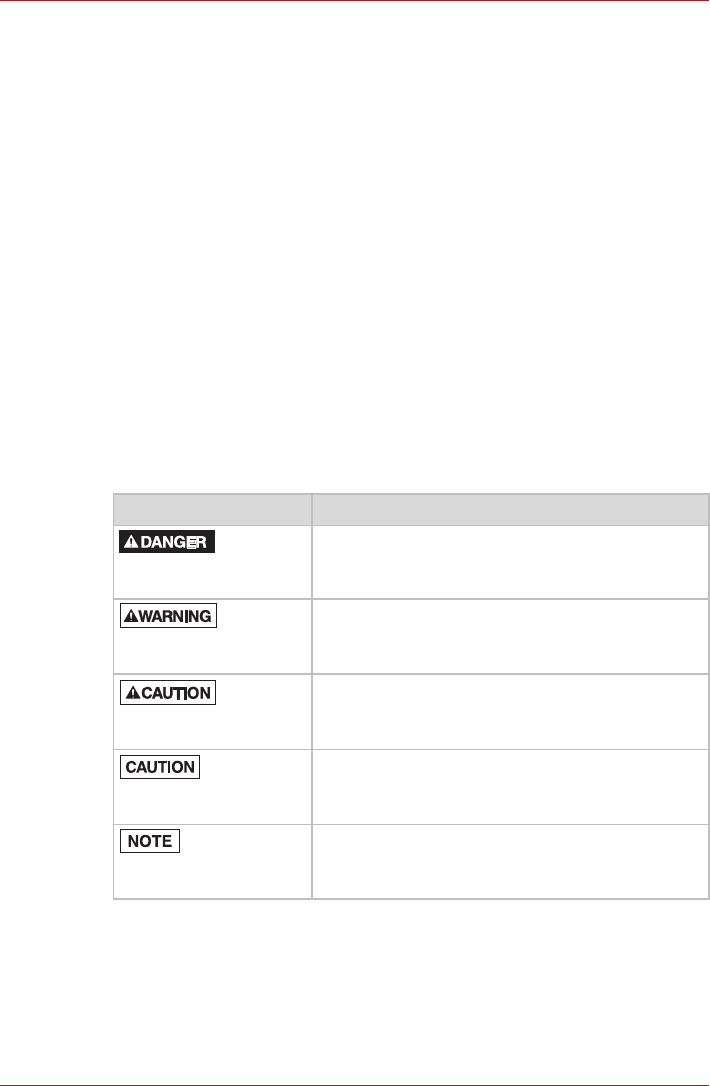
User’s Manual EN-3
dynadockTM WiAC
Conventions
This manual uses the following formats to describe, identify, and highlight
terms and operating procedures.
Abbreviations
On first appearance, and whenever necessary for clarity, abbreviations are
enclosed in parentheses following their definition. For example: Read Only
Memory (ROM).
Icons
Icons identify ports, dials, and other parts of your dynadockTM. The indicator
panel also uses icons to identify components.
Safety icons
This guide contains safety instructions that must be observed to avoid
potential hazards that could result in personal injuries, damage to your
equipment, or loss of data. These safety cautions have been classified
according to the seriousness of the risk, and icons highlight these
instructions as follows:
Signal Words Meaning
Indicates an imminently hazardous situation
which, if not avoided, will result in death or
serious injury.
Indicates a potentially hazardous situation which,
if not avoided, could result in death or serious
injury.
Indicates a potentially hazardous situation which,
if not avoided, may result in minor injury or
moderate injury.
Indicates a potentially hazardous situation which,
if not avoided, may result in property damage.
Provides important information.

EN-4 User’s Manual
dynadockTM WiAC
Safety Instructions
Always read the safety instructions carefully:
Do not disassemble, modify, tamper with or repair your product
■Do not attempt to disassemble, modify, tamper with or repair product
(including AC adaptor). Disassembly, modification, tampering or
repairing the product could cause fire or electric shock, possibly
resulting in serious injury.
Please contact an authorized Toshiba service provider for any repair
service.
Handling the AC adaptor and power cables/cords or plugs
■When handling the power cable/cord, follow these precautions:
■Never tamper with the power cable/cord or plug.
■Never splice or alter a power cable/cord.
■Never bend or twist a power cable/cord.
■Never pull on a power cable/cord to remove a plug from a socket.
Always grasp the plug directly.
■Never place heavy objects on a power cable/cord.
■Never run a power cable/cord through a pinch point such as a door
or window.
■Never place a power cable/cord near a heat source.
■Never use nails, staples or similar objects to fasten or attach cord in
place.
■Never attempt to disassemble or repair an AC adaptor.
Doing any of the above may damage the cables, and/or result in a fire
or electric shock, possibly resulting in serious injury.
The mains plug is used as a disconnecting device and therefore should
be readily operable.
Attaching the power cable/cord
■Always confirm that the power plug (and extension cable plug if used)
has been fully inserted into the socket, to ensure a secure electrical
connection. Failure to do so may result in a fire or electric shock,
possibly resulting in serious injury.
■Be careful if you use a multiple connector. An overload on one socket
could cause a fire or electric shock, possibly resulting in serious injury.

User’s Manual EN-5
dynadockTM WiAC
Dust on the power plug connectors or connector base
■If dust gets on the power plug connectors or connector base, turn the
power off and disconnect the power plug. Then clean the connector
and/or connector base with a dry cloth. Continuing to use the product
without cleaning the power plug may result in a fire or an electric shock,
possibly resulting in serious injury.
Only use TOSHIBA AC adaptor
■Always use the TOSHIBA AC adaptor that was provided with your
product (that may have been provided with your product), or use AC
adaptors specified by TOSHIBA to avoid any risk of fire or other
damage to the product. Use of an incompatible AC adaptor could cause
fire or damage to the product possibly resulting in serious injury.
TOSHIBA assumes no liability for any damage caused by use of an
incompatible adaptor or charger.
Use correct power source
■Never plug the AC adaptor into a power source that does not
correspond to both the voltage and the frequency specified on the
regulatory label of the unit. Failure to do so could result in a fire or
electric shock, possibly resulting in serious injury.
Do not handle the power plug with wet hands
■Never attempt to connect or disconnect a power plug with wet hands.
Failure to follow this instruction could result in an electric shock,
possibly resulting in serious injury.
Choking hazards
■Never leave small parts such as covers, caps and screws within the
reach of infants or small children. Swallowing a small part may cause
choking and suffocation resulting in death or serious injury. If a part is
swallowed, immediately take appropriate emergency action and consult
a doctor.
Avoid liquids, moisture and foreign objects
■Never allow any liquids to spill into any part of your product, and never
expose the product to rain, water, seawater or moisture. Exposure to
liquid or moisture can cause electric shock or fire, resulting in damage
or serious injury. If any of these eventualities should accidentally occur,
immediately:
1. Turn off the product.
2. Disconnect the AC adaptor from the power plug socket and product.
Do not turn on the power again, until you have taken the product to an
authorized service center. Failure to follow these instructions could
result in serious injury or permanent damage to the product.

EN-6 User’s Manual
dynadockTM WiAC
Never place your product or AC adaptor on a heat sensitive surface
■Never place your product or AC adaptor on a wooden surface, furniture,
or any other surface that could be marred by exposure to heat since the
product base and AC adaptor’s surface increase in temperature during
normal use.
■Always place your product or AC adaptor on a flat and hard surface that
is resistant to heat damage.
Never place your product in locations with excess heat
■Never place your product where it will be exposed to excess heat, such
as in direct sunlight, an unventilated vehicle or near a heater. This may
result in a system failure, malfunction, loss of data or damage to the
product.
Never place your product in a location with extremely low
temperatures
■Never place your product in a location where it will be exposed to
extremely low temperatures. This may result in a system failure,
malfunction or loss of data.
Never subject your product to sudden temperature variations
■Never subject your product to sudden temperature variations. This may
result in condensation, causing a system failure, malfunction or loss of
data.
Never operate your product during a thunderstorm
■Never operate your product on AC power during a thunderstorm. If you
see lightning or hear thunder, immediately turn off the product. An
electric surge caused by the storm, may result in a system failure, loss
of data or hardware damage.
Regulatory Statements
Federal Communications Commission(FCC)
This equipment has been tested and found to comply with the limits for a
Class B digital device, pursuant to part 15 of the FCC rules. These limits
are designed to provide reasonable protection against harmful interference
in a residential installation.
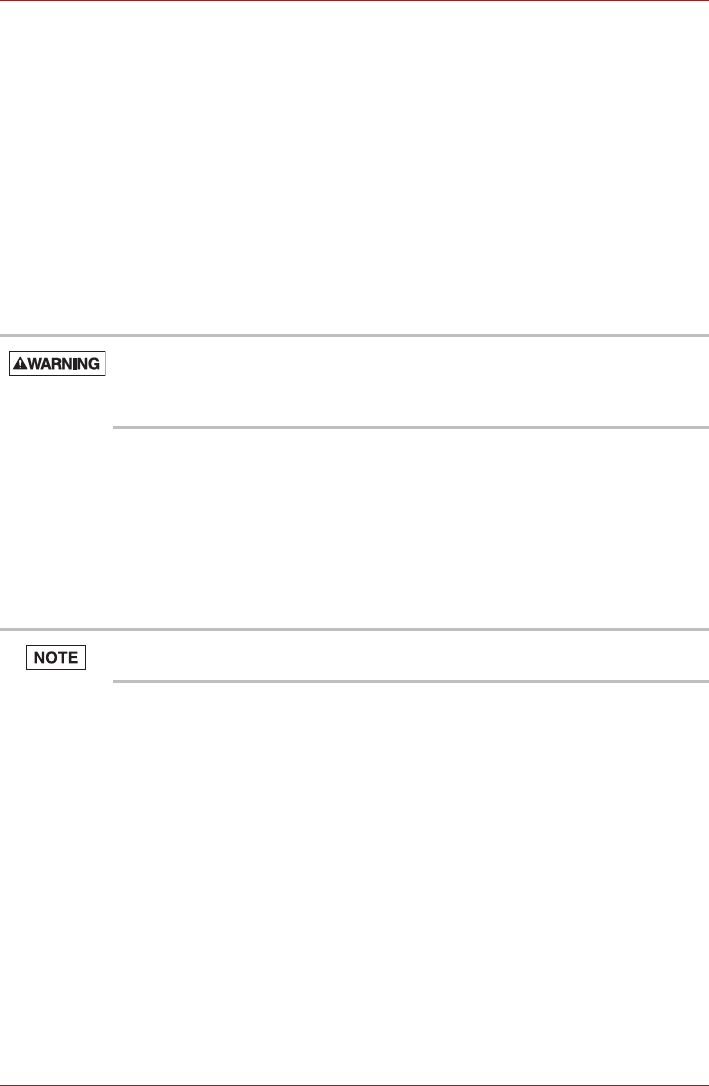
User’s Manual EN-7
dynadockTM WiAC
This equipment generates, uses and can radiate radio frequency energy
and, if not installed and used in accordance with the instructions, may
cause harmful interference to radio communications. However, there is no
guarantee that interference will not occur in a particular installation. If this
equipment does cause harmful interference to radio or television reception,
which can be determined by turning the equipment off and on, the user is
encouraged to try to correct the interference by one or more of the following
measures:
■Reorient or relocate the receiving antenna(s).
■Increase the separation between the equipment and receiver.
■Connect the equipment into an outlet on a circuit different from that to
which the receiver is connected.
■Consult the dealer or an experienced radio/TV technician for help.
Declaration of Conformity for Products Marked with the FCC Logo
(USA)
This device complies with Part 15 of the FCC Rules. Operation is subject to
the following two conditions:
(1) this device may not cause harmful interference, and
(2) this device must accept any interference received, including
interference that may cause undesired operation.
Industry Canada (IC)
This device complies with Industry Canada licence-exempt RSS
standard(s). Operation is subject to the following two conditions: (1) this
device may not cause interference, and (2) this device must accept any
interference, including interference that may cause undesired operation of
the device.
Le présent appareil est conforme aux CNR d’Industrie Canada applicables
aux appareils radio exempts de licence. L’exploitation est autorisée aux
deux conditions suivantes: (1) l’appareil ne doit pas produire de brouillage;
(2) l’utilisateur de l’appareil doit accepter tout brouillage radioélectrique
subi, même si le brouillage est susceptible d’en compromettre le
fonctionnement.
This equipment must be installed and operated in accordance with provided
instructions and the antenna(s) used for this transmitter must be installed to
provide a separation distance of at least 20 cm from all persons and must not
be co-located or operating in conjunction with any other antenna or transmitter.
Changes or modifications to this equipment not expressly approved by Toshiba
could void the user's authority to operate this equipment.

EN-8 User’s Manual
dynadockTM WiAC
CE Compliance
Working Environment
This product was designed to fulfil the EMC (Electromagnetic Compatibility)
requirements to be observed for so-called “Residential, commercial and
light industry environments”. TOSHIBA do not approve the use of this
product in working environments other than the above mentioned
“Residential, commercial and light industry environments”.
For example, the following environments are not approved:
■Industrial Environments (e.g. environments where a mains voltage of
380 V three-phase is used)
■Medical Environments
■Automotive Environments
■Aircraft Environments
Any consequences resulting from the use of this product in working
environments that are not approved are not the responsibility of TOSHIBA.
The consequences of the use of this product in non-approved working
environments may be:
■Interference with other devices or machines in the near surrounding
area.
■Malfunction of, or data loss from, this product caused by disturbances
generated by other devices or machines in the near surrounding area.
Therefore TOSHIBA strongly recommend that the electromagnetic
compatibility of this product should be suitably tested in all non-approved
working environments before use. In the case of automobiles or aircraft, the
manufacturer or airline respectively should be asked for permission before
use of this product.
Furthermore, for general safety reasons, the use of this product in
environments with explosive atmospheres is not permitted.
REACH
Following information is only valid for EU-member States:
REACH - Compliance Statement
The European Union (EU) chemical regulation, REACH (Registration,
Evaluation, Authorization and Restriction of Chemicals), entered into force
on 1 June 2007, with phased deadlines to 2018.
This product is CE marked in accordance with the
requirements of the applicable EU Directives. Responsible
for CE marking is TOSHIBA EUROPE GMBH,
Hammfelddamm 8, 41460 Neuss, Germany. A copy of the
official Declaration of Conformity can be obtained from
following website: http://epps.toshiba-teg.com.

User’s Manual EN-9
dynadockTM WiAC
Toshiba will meet all REACH requirements and is committed to provide our
customers with information about the presence in our articles of substances
included on the candidate list according to REACH regulation.
Please consult the website www.toshiba.eu/reach for information about the
presence in our articles of substances included on the candidate list
according to REACH in a concentration above 0.1% weight by weight.
Wireless Devices and your health
Wireless products, like other radio devices, emit radio frequency
electromagnetic energy. The level of energy emitted by Wireless products
however is far much less than the electromagnetic energy emitted by
wireless devices like for example mobile phones.
Because Wireless products operate within the guidelines found in radio
frequency safety standards and recommendations, TOSHIBA believes
Wireless products are safe for use by consumers. These standards and
recommendations reflect the consensus of the scientific community and
result from deliberations of panels and committees of scientists who
continually review and interpret the extensive research literature.
In some situations or environments, the use of Wireless products may be
restricted by the proprietor of the building or responsible representatives of
the organization. These situations may for example include:
■Using the Wireless products equipment on board of airplanes, or
■In any other environment where the risk of interference to other devices
or services is perceived or identified as harmful.
If you are uncertain of the policy that applies on the use of wireless devices
in a specific organization or environment (e.g. airports), you are
encouraged to ask for authorization.
Following information is only valid for EU-member States:
Disposal of products
The crossed out wheeled dust bin symbol indicates that
products must be collected and disposed of separately from
household waste.
The black bar indicates that the product was placed on the
market after August 13, 2005.
By participating in the separate collection of products, you
will help to assure the proper disposal of products and thus
help to prevent potential negative consequences for the
environment and human health.
For more detailed information about the collection and
recycling programmes available in your country, please visit
our website (www.toshiba.eu/recycling) or contact your local
council office or the retail outlet where you purchased the
product.

EN-10 User’s Manual
dynadockTM WiAC
Copyright Statement
No part of this publication may be reproduced in any form by any means
without prior written permission. Other trademarks or brand names mentioned
herein are trademarks or registered trademarks of their respective companies.
Disclaimer
Information in this document is subject to change without notice. The
manufacturer does not make any representations or warranties (implied or
otherwise) regarding the accuracy and completeness of this document and
shall in no event be liable for any loss of profit or any commercial damage,
including but not limited to special, incidental, consequential, or other
damage.
August 2015, Rev1.0
Trademarks
dynadock is a trademark of Toshiba Corporation.
Intel, Intel Core, Pentium and Celeron are trademarks or registered
trademarks of Intel Corporation.
Windows, Microsoft and Windows logo are registered trademarks of
Microsoft Corporation.
DisplayLink is a trademark of DisplayLink Corporation.
AMD is registered trademark or trademark of Advanced Micro Devices
Incorporated.
Ethernet is a registered trademark and Fast Ethernet is a trademark of
Xerox Corporation.
The terms HDMI and HDMI High-Definition Multimedia Interface, and the
HDMI Logo are trademarks or registered trademarks of HDMI Licensing
LLC in the United States and other countries.
DisplayPort is a wordmark of the Video Electronics Standards Association.
Other brands and product names are trademarks or registered trademarks
of their respective companies.
TOSHIBA Support
Need help?
For the latest driver updates, User’s Manuals & FAQs, please have a look
at the TOSHIBA options & services support page:
computers.toshiba.eu/options-support
For the TOSHIBA hotline numbers, please see
computers.toshiba.eu/options-warranty

User’s Manual EN-11
dynadockTM WiAC
Precautions for Microsoft
®
Windows
®
7 and
Windows 8.1
Due to the many configurations of computers and Windows® operation
systems available, functionality may differ slightly than stated in the user
manual. This might be due to the computer manufactures BIOS and other
custom configurations of the hardware, pre-installed software or operating
system installed at time of production. If you are having specific problems,
you might need to contact the computer manufacturer to inquire if there are
BIOS, hardware driver or operating system updates.
The Fn + F4 or Fn + F5 functionality detailed in the electronic User’s Guide
for your TOSHIBA computer only controls the internal video controller of
your computer.
This product does not support 3D programs.
In some software application programs that utilize certain direct draw
commands such as some 2D-Games, the display on the external monitor
connected to the dynadock will not be supported. If you want to play these
games in full screen, we suggest you disconnect the dynadock.
This product is unable to enter full screen DOS mode when using the
external monitor connected to the dynadock.
Depending on your computer system, you might receive a warning
message if the external monitor connected to your dynadock is used as
your primary display.
USB, CPU resources and other devices might be affected when playing
movies or transferring large amounts of data via the dynadock.
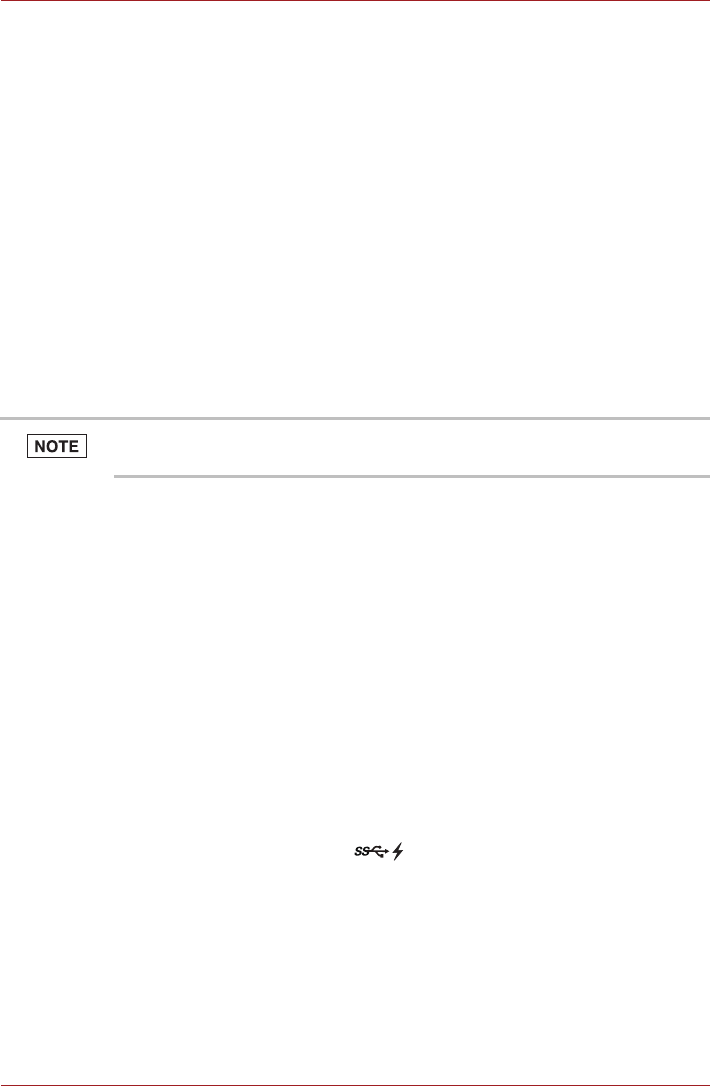
EN-12 User’s Manual
dynadockTM WiAC
Introduction
Thank you for purchasing the Toshiba dynadockTM WiAC, the universal
docking station that enables you to connect your computer peripherals
wirelessly or through one USB cable to just about any Windows-based
computer. It can also be used as a wireless AP (Access Point) for other
users to go to the Internet simultaneously. Increased mobility and the
absence of cabling is beneficial for your network. You can enjoy a better
Internet experience when downloading, gaming, video streaming or with
any other application that you might wish to use.
The dynadock is software upgradable to enable you to keep your dynadock
in line with technological advances.
Visit www.toshiba.eu/download-drivers for the latest software driver support
updates.
Please select OPTIONS -> CONNECTIVITY -< DOCKS & PORT
REPLICATORS -< DYNADOCK WiAC from the drop-down menu, then
click SEARCH.
Features
■Wireless or single USB cable connection to your computer
■Horizontal style design to get better stability
■Supports to be mounted to the wall
■Easily accessible USB and audio port located on the front
■Supports USB 3.0 and backward compatible with USB 2.0
■Supports HDMI® and DisplayPort dual display
■Supports video resolutions up to 2560 x 1600 on an external display
and 2048 x 1152 for dual display
■Hot-swappable: add or remove most devices without rebooting the
computer
■Supports to be used as a wireless AP (Access Point)
■Can charge your USB devices (DC 5V/port) with the powered "USB
Sleep and Charge" ports ( ) even when your computer is
undocked or off.
The dynadock
TM
and dynadock described in this manual refer to the
dynadock
TM
WiAC.

User’s Manual EN-13
dynadockTM WiAC
Package Contents
Check to make sure you have all of the following items:
■dynadock
TM
WiAC
■AC adaptor and power cord
■USB 3.0 cable
■Wall mount parts
■Quick Start Guide
■Warranty leaflet
Computer Requirements
Component Requirement
CPU 2 GHz or higher processor (Intel® Core i5/i7 family, or
AMD Liano family, or compatible processor
recommended. Intel® Core™ i7 2 GHz or higher
processor recommended for optimal video
performance)
Wireless
module
a computer integrated with 802.11ac Wireless LAN
module and backward compatible with 802.11a/n
Memory 4 GB memory or higher
USB interface USB 3.0 or 2.0 port (3.0 recommended for optimal
performance)
Operating
system
Microsoft® Windows® 7 (32-bit or 64-bit editions) or
Windows 8.1 (32-bit or 64-bit editions)
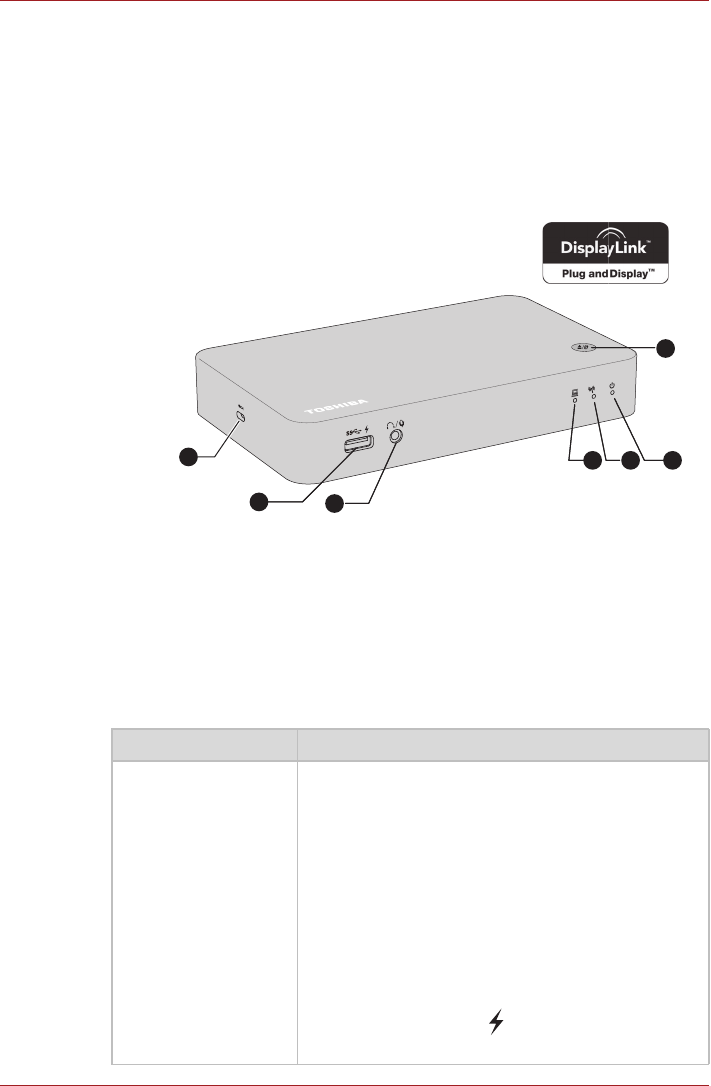
EN-14 User’s Manual
dynadockTM WiAC
Quick Tour
This section identifies the various components of the dynadock.
Front
The following illustration shows the front of the dynadock. For a description
of each component, refer to the accompanying table.
(Sample Illustration) The front of the dynadock
1. Universal Serial Bus (USB 3.0) port 5. Power indicator
2. Headphone/Microphone combo jack 6. Security lock slot
3. USB upstream indicator 7. WPS/Undock button
4. Wireless communication indicator
Component Description
Universal Serial Bus
(USB 3.0) port
(USB Sleep and
Charge port)
One Universal Serial Bus port, which complies to
the USB 3.0 standard, is provided on the front
panel of the dynadock.
This port connects and charges the selected
USB peripherals (for example, MP3 players and
smartphones) even when the dynadock is
disconnected from your computer or your
computer is off.
The USB 3.0 port is compliant with USB 3.0
standard and backward compatible with USB 2.0
devices.
The port with the icon ( ) has sleep and charge
function.
12
43 5
6
7

User’s Manual EN-15
dynadockTM WiAC
■Note that it is not possible to confirm the operation of all functions of all
USB devices that are available. Some functions associated with a
specific device might not operate properly.
■Only the USB 3.0 port on the front panel supports wake-up on USB.
■If your USB device, such as a printer or optical drive, and so on, came
with its own AC adaptor, make sure that it is plugged into the device
and a live electrical outlet.
Component Description
Headphone/
Microphone combo
jack
A 3.5 mm mini headphone/microphone combo jack
enables connection of a monaural microphone or
stereo headphones.
USB upstream
indicator
Glows green when the dynadock is connected to
the computer through the USB upstream
connector.
Wireless
communication
indicator
Glows green when the dynadock is successfully
connected to the computer and flashes green
when there is a data transferring.
Power indicator Glows green when the power is being supplied
from the AC adaptor and the dynadock is switched
on.
Security lock slot A security cable can be attached to this slot and
then connected to a desk or other object to deter
theft of the dynadock. For more information on
purchasing an optional security lock, visit
www.toshiba.eu/accessories
WPS/Undock button Press this button for 1 second to undock the
dynadock from the computer and about 5 seconds
to enable WPS function.
Refer to the WPS function section for detailed
information.
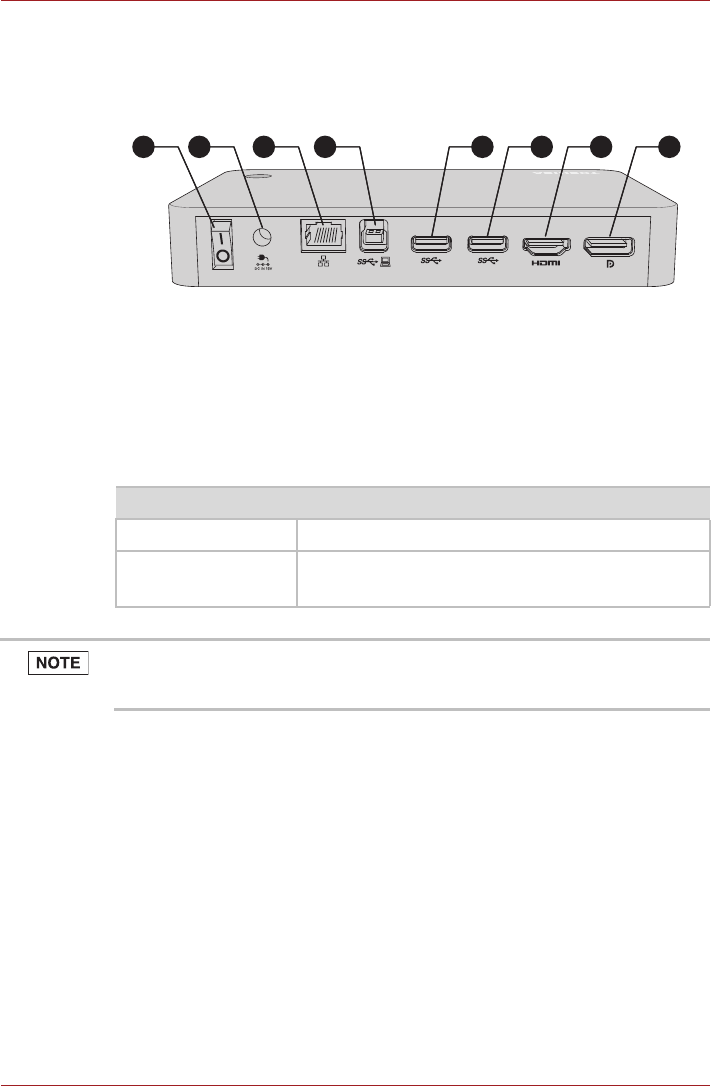
EN-16 User’s Manual
dynadockTM WiAC
Back
The following illustration shows the back of the dynadock. For a description
of each component, refer to the accompanying table.
(Sample Illustration) The back of the dynadock
1. Power switch 5. Universal Serial Bus (USB 3.0) port
2. DC IN 19V jack 6. Universal Serial Bus (USB 3.0) port
3. LAN jack 7. HDMI out port
4. USB upstream connector 8. DisplayPort
Component Description
Power switch Switch to turn on/off the dynadock.
DC IN 19V jack The AC adaptor connects to this jack to power the
dynadock.
1 2 3 4 5 6 7 8
The dynadock requires an external power supply, as it does not draw
power from the USB bus of the computer.
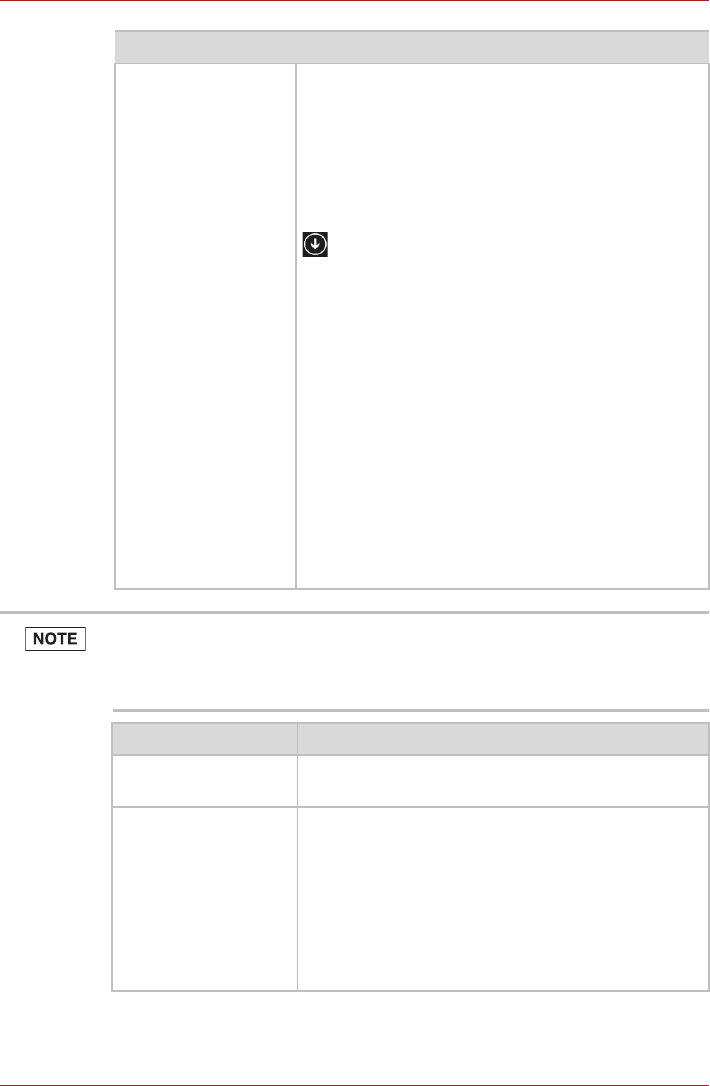
User’s Manual EN-17
dynadockTM WiAC
Component Description
LAN jack
(10/100/1000 BASE-
TX Ethernet)
This jack lets you connect to a LAN via a network
cable (not provided). Connect one end of a network
cable to the Ethernet port (RJ-45) on the dynadock
and the other end to your network for high
performance network access. To configure the
network properties of the Ethernet adaptor:
In Windows 8.1, move the mouse pointer and click
icon in the lower-left corner of the screen to get
to the Apps view, and then click Control Panel ->
Network and Internet -> View network status
and tasks -> Change adapter settings.
In Windows® 7, select Start -> Control Panel ->
Network and Internet -> View network status
and tasks -> Change adapter settings.
In the Network Connections folder, double-click the
connection icon for the Ethernet adaptor of the
dynadock, which is indicated by dynadock
Ethernet. This opens the Local Area Connection
Properties window for you to configure the network
settings as required according to your network
environment. If you are unsure about the settings,
consult your network administrator for assistance.
■The LAN jack does not support wake-up on LAN.
■The Local Area Connection icon in the System Tray/Notification Area
does not show a connection. Open “Network Connections” to view the
Ethernet Connection.
Component Description
USB upstream
connector
It connects the dynadock to the computer (type B
to type A cable provided).
Universal Serial Bus
(USB 3.0) ports
Two Universal Serial Bus ports, which comply to
the USB 3.0 standard, are provided on the back
panel of the dynadock.
These two ports connect the selected
USB peripherals.
The USB 3.0 port is compliant with USB 3.0
standard and backward compatible with USB 2.0
devices.
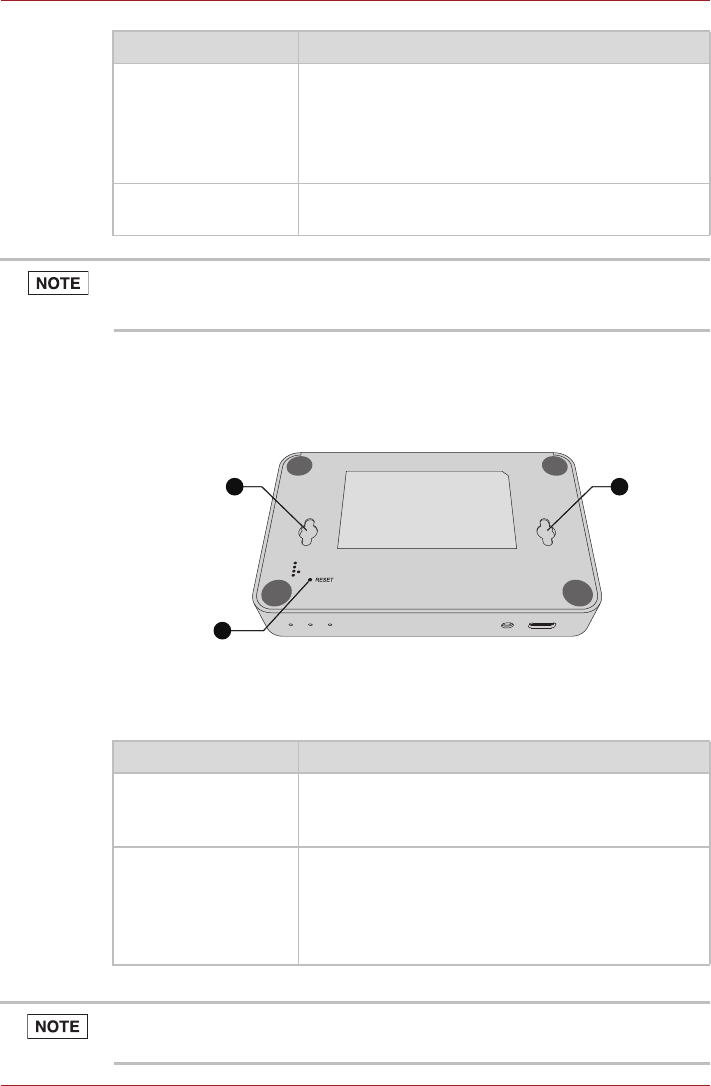
EN-18 User’s Manual
dynadockTM WiAC
Underside
The following illustration shows the underside of the dynadock. For a
description of each component, refer to the accompanying table.
(Sample Illustration) The underside of the dynadock
HDMI out port HDMI out port can connect with Type A connector
HDMI cable (supports video and up to 5.1
surround sound). An HDMI cable sends video and
audio signals. In addition, it can send and receive
control signals.
DisplayPort This port is for a connection to a DisplayPort
device.
Component Description
HDMI out port and DisplayPort can be used simultaneously for a dual
display.
1. Hook holes 2. Reset button
Component Description
Hook holes These two holes allow you to mount the dynadock
to any other available place by using the provided
wall mount parts.
Reset button Use a slender object (such as a pin) to press and
hold the reset button about 15 seconds until the
power indicator becomes quick-flash from slow-
flash. And then release the button and wait the
dynadock to reboot to its factory default settings.
11
2
Ensure the dynadock is powered on before it restarts completely.
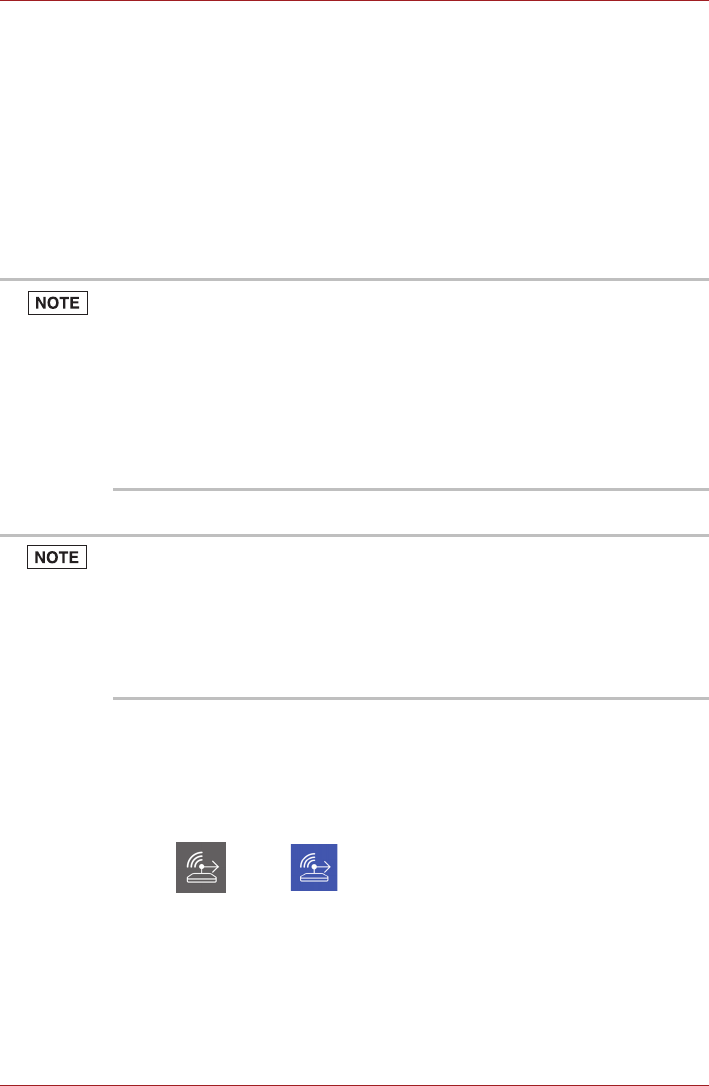
User’s Manual EN-19
dynadockTM WiAC
Using your dynadock for the first time
This section provides basic information to start using your dynadock.
Installing the Drivers
1. The drivers are provided at www.toshiba.eu/download-drivers. Please
select OPTIONS -< CONNECTIVITY -< DOCKS & PORT
REPLICATORS -< DYNADOCK WiAC from the drop-down menu, then
click SEARCH.You can save it to a storage device and then install to
your computer.
2. Restart your computer if prompted.
The UDS icon which allows you to dock/undock with the dynadock appears
in the system tray/notification area after the installation is successfully
completed.
It is displayed in two different colors depending on the docking status. The
grey icon indicates the undocking status while the blue one indicates the
dockig status.
(Sample Image) UDS icon
Connecting the AC adaptor
1. Connect the power cord to the AC adaptor.
■You might need to temporarily disable anti-spyware or anti-virus
programs while installing the drivers. It is also recommended that all
other applications are closed, as you will need to restart your computer
after the drivers are installed.
■You need administrator privilege to install/uninstall the drivers.
■Installation files with the latest drivers are also available for download
at www.toshiba.eu/download-drivers. Check periodically for updates.
■You must read and accept the TOSHIBA software license agreement
when prompted, to proceed with the installation.
■Complete the software installation process before connecting the
dynadock (wirelessly or through the provided USB cable) to your
computer.
■Restarting may take longer than usual if the operating system of the
computer is configured to create a system restore point after a new
device is installed. This occurs after initial installation only. When the
computer restarts, the dynadock is ready to use.
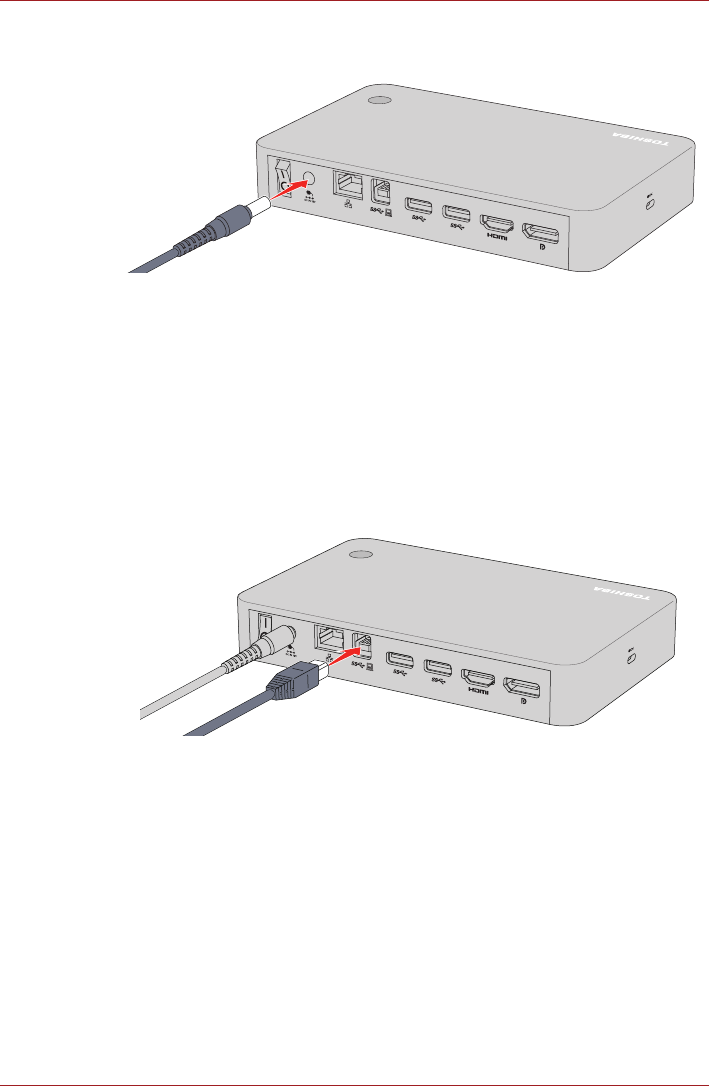
EN-20 User’s Manual
dynadockTM WiAC
2. Connect the DC output plug of the AC adaptor to the DC IN 19V jack on
the dynadock.
(Sample Illustration) Connecting the AC adaptor cord to the dynadock
3. Plug the power cord into a live wall outlet.
4. Switch to turn on the dynadock. The power indicator on the front panel
glows green.
Connecting/Docking your computer
There are several ways to connect/dock you computer:
■Plug the square end of the USB cable into the USB upstream port on
the back of the dynadock and plug the other end into your computer.
(Sample Illustration) Connecting the USB cable to the dynadock
■To connect the dynadock wirelessly, right-click the UDS icon in the
Notification Area of your Windows® desktop and select “Dock with
dynadockWiAC_xxxxxx”.
■To connect the dynadock wirelessly, click the Internet icon in the
Notification Area of your Windows® desktop and connect to
“dynadockWiAC_xxxxxx”.
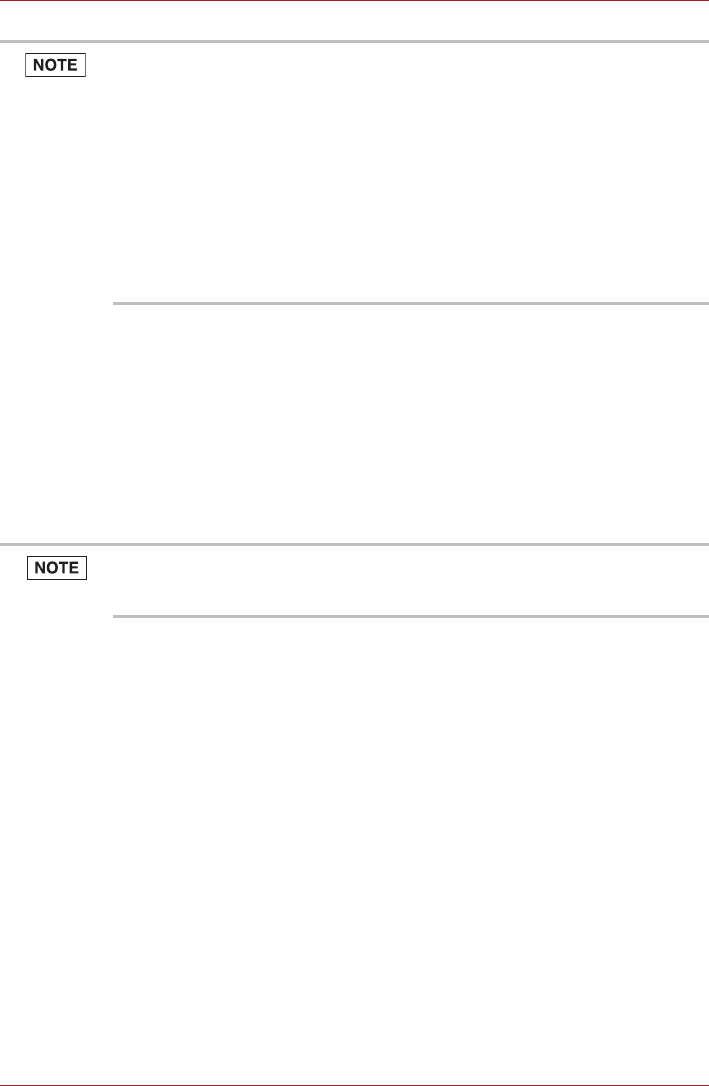
User’s Manual EN-21
dynadockTM WiAC
Disconnecting/Undocking your computer
There are several ways to disconnect/undock you computer:
■Directly unplug the cable from the computer if it is connected.
■While connecting the dynadock wirelessly, right-click the UDS icon in
the Notification Area of your Windows® desktop and select “Undock with
dynadockWiAC_xxxxxx”.
■While connecting the dynadock wirelessly, click the Internet icon in the
Notification Area of your Windows® desktop and disconnect from
“dynadockWiAC_xxxxxx”.
Configuring Audio Ports
You can play back or record audio either through the audio port of the
dynadock or the docked computer. However, you cannot use the audio
ports on the docked computer and on the dynadock at the same time.
Upon docking connection, the audio port on the dynadock might become
enabled and the audio ports on the computer disabled. When you undock
the computer, the audio ports on the computer are re-enabled
automatically.
■The name of the dynadock is displayed as “dynadockWiAC_xxxxxx”,
which differs from models.
■Some computers might not immediately recognize that the dynadock is
connected upon start-up. This is related to the computers BIOS start up
sequence but not a malfunction of the dynadock. If this occurs, do the
following:
1. Turn off the computer
2. Disconnect the dynadock from the computer.
3. Turn the computer back on.
4. Connect the dynadock to the computer once the operating system
of the computer has loaded.
If a USB storage device is connected to the dynadock, make sure that you
save the data located on the USB device, and then remove the USB device
first before undocking.
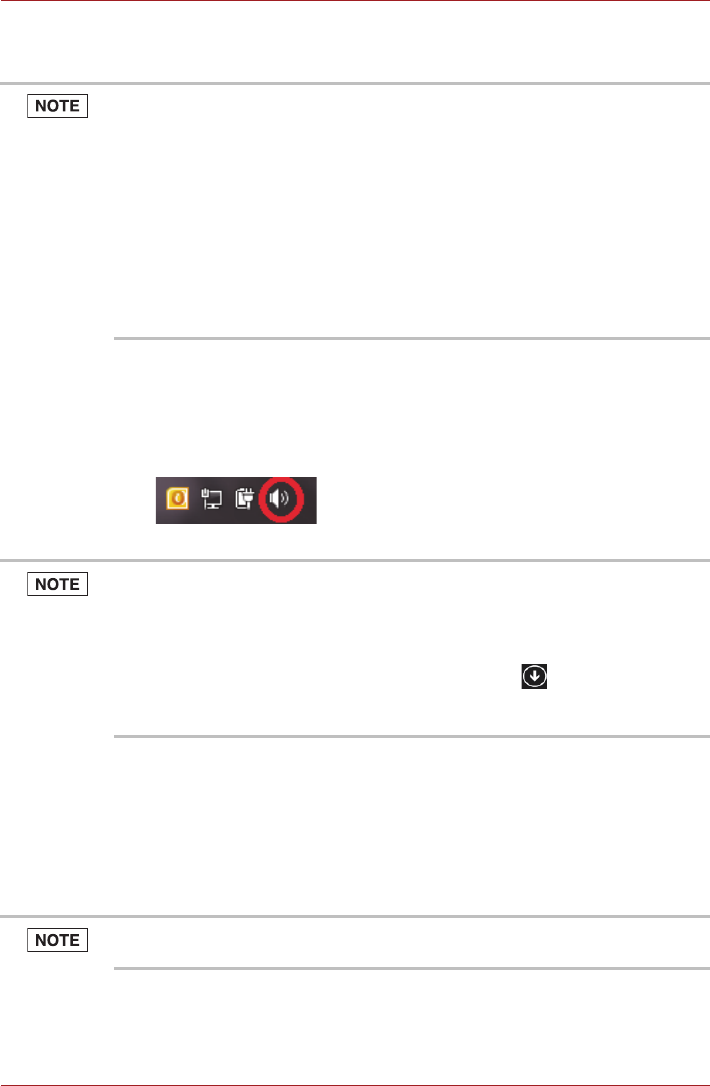
EN-22 User’s Manual
dynadockTM WiAC
To change the default settings, you might need to adjust the audio settings
in Windows® manually, as described in this section.
Configuring audio playback ports (Headphone)
1. Right-click the speaker icon in the Notification Area of your Windows®
desktop.
(Sample Image) Speaker icon
2. Select Playback Devices from the menu.
3. On the Playback tab of the dialog box, select one of the following:
■A Realtek High Definition Audio device—to use the Headphone/
Line out jack of the docked computer (The Realtek High Definition
Audio is provided with some computers.)
■A dynadock Audio device—to use the Headphone/Microphone
combo jack of the dynadock
4. Click Set Default.
5. Click OK.
6. Connect your playback device to the jack you enabled in step 3.
■If there is no audio device connected to the dynadock, the audio ports
on the computer are enabled automatically.
■If your media player is running when you undock or dock, you must
close the application and wait approximately 10-15 seconds for the new
settings to take effect before restarting the application.
■Audio devices connected to the dynadock via the 3.5 mm audio jack
appear as dynadock Audio device in Windows®.
■When your computer is docked, SPDIF and Line in ports might display
in Windows® audio properties dialog boxes. These ports should appear
as “Currently unavailable” and are actually not provided by the
dynadock.
If the speaker icon is not visible in the Notification Area, access the audio
configuration utility through the following Start menu:
In Windows® 7, click Start -> Control Panel -> Hardware and Sound ->
Sound.
In Windows 8.1, move the mouse pointer and click icon in the
lower-left corner of the screen to get to the Apps view, and then click
Control Panel -> Hardware and Sound -> Sound.
There might be other Audio devices listed in the menu depending on the
model of your computer.
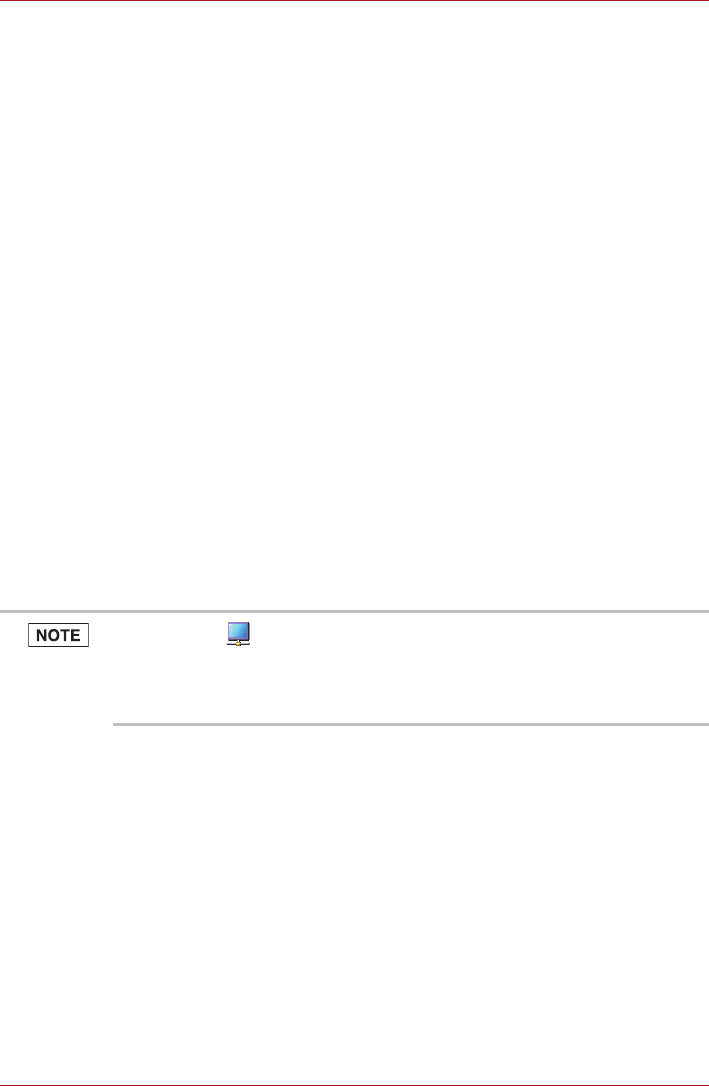
User’s Manual EN-23
dynadockTM WiAC
Configuring audio recording ports (Microphone)
1. Right-click the speaker icon in the Notification Area of your Windows®
desktop.
2. Select Recording Devices from the menu.
3. On the Recording tab of the dialog box, select one of the following:
■A Realtek High Definition Audio device—to use the Microphone
jack or headphone/microphone combo jack of the docked computer
■A dynadock Audio device—to use the headphone/microphone
combo jack of the dynadock
4. Click Set Default.
5. Click OK.
6. Connect your recording device to the jack you enabled in step 3.
Configuring Video Ports
Connection
The dynadock provides the following video ports:
HDMI – for connection to HDMI (using the HDMI cable which is not
provided) interface monitors. (up to 2560 x 1440 pixels)
DisplayPort – for connection to DisplayPort (using the DisplayPort
cable which is not provided) interface monitors. (up to 2560 x 1600
pixels)
Connect the monitor cable (not provided) to the video output port on the
dynadock and the external monitor. This cable can be connected and
disconnected any time without disconnecting the dynadock from your
computer.
You can customize the video settings of the dynadock. See section for more
information.
Viewable screens
The dynadock video drivers give you the option of viewing a total of four
screens:
■the screen on the computer
■an external monitor connected to the video port on the computer (if
available)
■two external monitors connected to the dynadock
■The icon ( ) appears in the system tray after connecting an external
display to the dynadock.
■When using the DisplayPort and the HDMI out port simultaneously, the
resolution is up to 2048 x 1152 pixels.
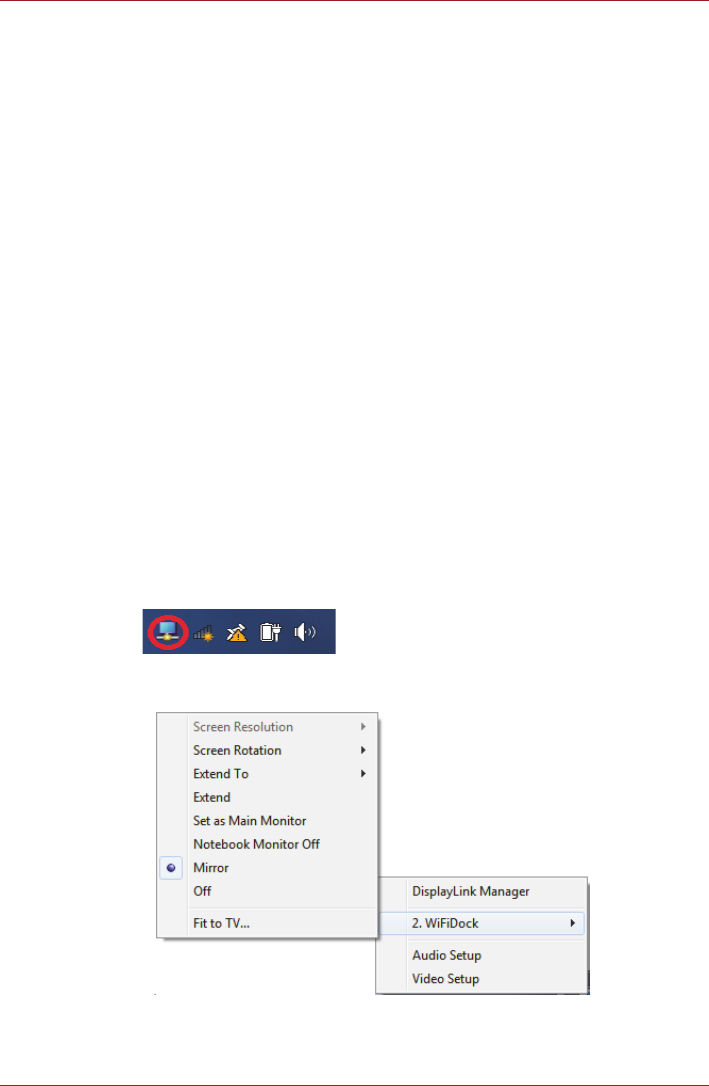
EN-24 User’s Manual
dynadockTM WiAC
Video Modes
The dynadock video output works in two modes:
■Mirror Mode
■Extend Mode
Mirror Mode
Mirror mode creates an identical display from your computer screen to the
external monitor. This is useful, for example, if you want to use a larger
desktop monitor rather than the computer screen. In Mirror Mode, the
dynadock automatically selects the settings (screen resolution, color quality
and refresh rate) for the external monitor that allows the best resolution
based on the settings of your computer.
Extend Mode
Extend Mode lets you split your display across multiple monitors. This
provides a number of advantages to increase productivity:
■View your large spreadsheets across two screens with display
continuity
■Multitask more effectively without overlapping windows
■Compare two documents simultaneously across two screens
■View videos/TV on one screen and reviews on the other
Set up the dynadock for Extend or Mirror Mode
1. Right-click the dynadock icon in the system tray/notification area.
(Sample Illustration) System tray/notification screen
2. Select Extend or Mirror from the menu.
(Sample Illustration) TOSHIBA Corp. DisplayLink Manager
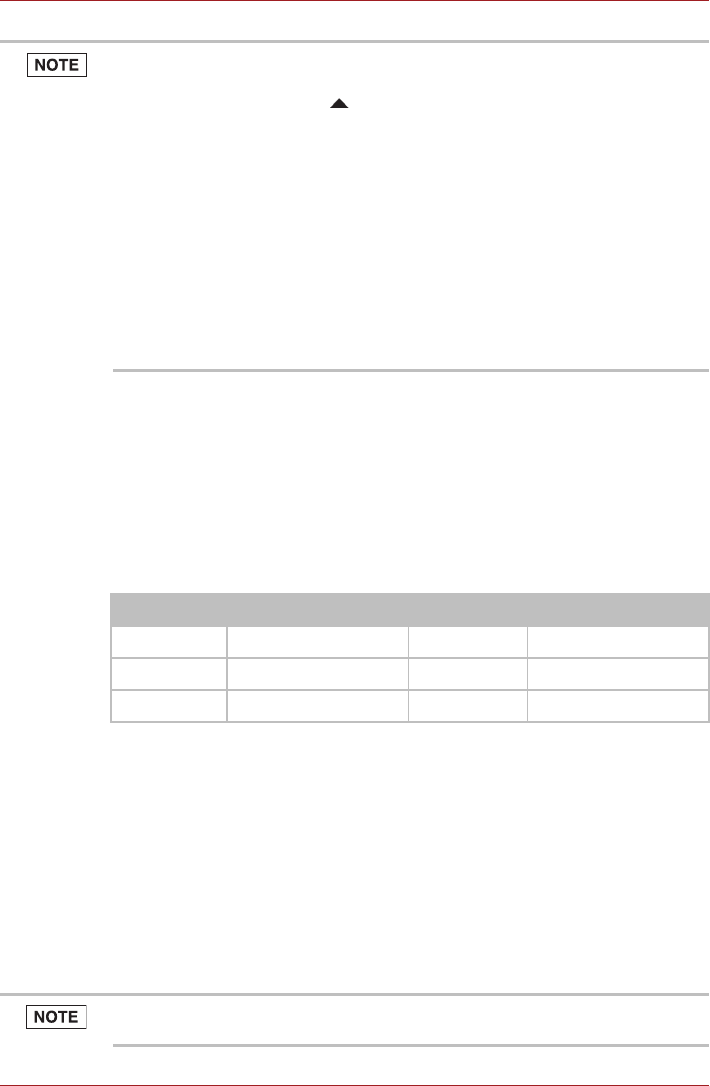
User’s Manual EN-25
dynadockTM WiAC
Adjusting Video Settings
There are several components that make up the screen mode:
Resolution: In common usage, this refers to the number of pixels displayed
on the screen horizontally and vertically.
Refresh rate: Measures the speed that the entire screen is rescanned.
Higher frequencies reduce flicker.
The dynadock supports the following display modes:
Note that interlaced modes are not supported and the resolutions listed in
this section might not be supported by your monitor.
Additional modes might be offered, depending upon the connected monitor,
but these are not currently guaranteed.
If the monitor does not advertise the supported modes, the HDMI/
DisplayPort component will choose a set of common screen modes.
If cloning the primary display, the HDMI/DisplayPort component will try to
use the preferred monitor mode. In some cases, this might not be the most
appropriate mode for the mirrored desktop. It is recommended that the
primary display resolution be changed to closer match the default
resolution of the dynadock monitor.
■If the icon is not visible in your system tray/notification area, make sure
that the dynadock is connected and docked, and then click the Show
Hidden Icons button ( ), if necessary, to display hidden icons.
■If you notice certain windows or other parts of your display are missing
when you disconnect your computer from the dynadock, you might
need to de-select the Extend desktop onto this display checkbox in
your Windows® Display settings to return the entire image to your
primary screen.
■You can also use the Windows® Display properties screen to switch
between Extend Mode and Mirror Mode.
■The external displays connected to the dynadock might be identified as
“2”, “3”, or “4” on the Windows® Display settings (depending on your
computer model), even though there might not be four viewable
displays.
Resolution Refresh Rates (Hz) Resolution Refresh Rates (Hz)
1600 x 1200 60 2048 x 1536 60
1920 x 1080 50, 60 2560 x 1440 50, 60
2048 x 1152 60 2560 x 1600 60
For more information on supported modes, be sure to check the
documentation supplied with your monitor.

EN-26 User’s Manual
dynadockTM WiAC
When the HDMI/DisplayPort component first starts, it will extend the
primary monitor. Changes to the screen mode and HDMI/DisplayPort
component operation mode can be made under the Windows display
properties. If no output is seen on the monitor connected to the HDMI/
DisplayPort component, it might be in a mode which cannot be displayed
by the monitor. This can happen if the monitor does not report its supported
modes to the HDMI/DisplayPort component. Reduce the resolution of the
primary display, and in turn the resolution of the HDMI/DisplayPort
component display until an image is shown.
Adjusting the Video Settings for the monitor connected to the
dynadock:
■Right-click the dynadock icon in the system tray/notification area, the
following options appears on the menu:
■dynadock WiAC
Screen Resolution: Change the resolution setting of the external
monitor connected to the dynadock.
Screen Rotation: Rotate the image on the external monitor connected
to the dynadock.
Extend To: Specify the extension direction if you are using multiple
monitors and Extend mode. This setting should match the physical
orientation of the connected monitors relative to each other. For
example, if the external monitor is physically positioned to the right of
your computer's display, select “Extend to Right”.
Extend: Extend your desktop space across multiple monitors, so that
you can display different information on each monitor connected to your
computer.
Set as Main Monitor: Sets screens in extend mode with external
monitor connected to the dynadock as the main monitor.
Notebook Monitor Off: Sets external monitor connected to the
dynadock as the main monitor and turns off the computer screen. (May
not appear when two displays are connected to the dynadock.)
Mirror: Duplicate the image showing on your computer screen on the
external monitor connected to the dynadock.
Off: Turn off the external display. Devices connected to the dynadock
still function.
Fit to TV: Grow or shrink the size of your Windows® desktop to match
your TV screen (enabled when applicable).
■Audio Setup
Shortcut to Windows® sound settings.
■Video Setup
Shortcut to Windows® display settings.
Placing the monitor into an unsupported mode for long periods can
damage it.
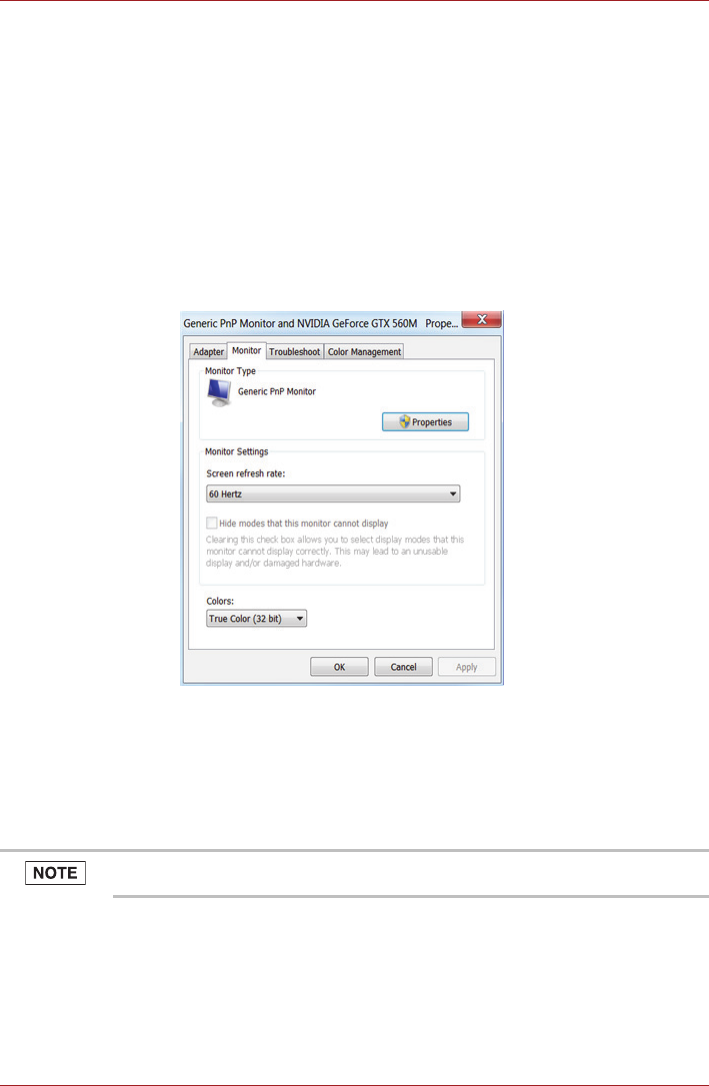
User’s Manual EN-27
dynadockTM WiAC
■To change the screen resolution, select those options on the screen. Be
sure to select one of the supported resolutions numbers in the table
above. For an external monitor, you can also select any resolution
supported by that monitor.
■To change the refresh rate, do the following:
1. Select Video Setup from the menu. This opens the Windows®
Display Settings screen.
2. On the Display Settings screen, click Advanced settings and then
click Monitor.
3. Select a refresh rate from the Screen refresh rate pull down list. Be
sure to select a refresh rate that is supported for the resolutions and
color depth settings, as indicated in the table above.
(Sample Illustration) Display setting screen
4. Click OK to close the Display Settings screen.
If you use multiple dynadocks with a single computer, for example, one at
work place and one at home, the video settings for each dynadock are
saved when you disconnect the computer. This enables you to have your
dynadock set up with different video settings for different locations. The
settings are retained each time you use the dynadock with your computer.
dynadock does not support Triple SLi systems.

EN-28 User’s Manual
dynadockTM WiAC
How Standby/Sleep/Hibernation Mode Affects
Devices Attached to the dynadock
External Monitors
The external monitor connected to the dynadock goes blank if the computer
enters standby/sleep/hibernation mode.
When in Mirror mode, the external monitor retains the settings it had
previoulsly when the computer resumes from standby/sleep/hibernation
mode.
When in Extend Mode, windows that were previously on the external
monitor might appear on the built-in display of the computer when the
computer resumes from standby/sleep/hibernation mode. You might need
to reposition the windows by dragging them to the external desktop again.
Also, if the external monitor is in Extend mode and the computer requires
you to log in after resuming from standby/sleep/hibernation mode, the login
screen appears on the primary computer display, not the external monitor.
This is consistent with Windows Operating System standards.
Other Devices
If another device is connected to a port on the dynadock and the computer
goes into standby/sleep/hibernation mode, that device does not function.
Using the AP (Access Point) function
This dynadock can be used as an AP (Access Point) while connected to the
Internet. It allows for greater range and mobility within your wireless
network while also allowing you to connect at least 10 wireless devices
simultaneously to a wired environment. Increased mobility and the absence
of cabling is beneficial for your network.
With multiple protection measures, including WiFi protected Access
(WPA2), as well as the WiFi Protected Setup (WPS) button, the dynadock
delivers complete data privacy.
Web Configurations
It supports an easy, web-based management page (Graphical User
Interface) to configure the AP function.

User’s Manual EN-29
dynadockTM WiAC
How to go to the Web Graphical User Interface
Follow these instructions to enter the web Graphical User Interface.
1. Click the UDS icon in the Notification Area of your Windows® desktop
and select “dynadock WiAC Configure Setting”.
Or, open your web browser, type in IP address http://192.168.1.1 in the
address field and press Enter.
2. Enter Username and Password. Both of them are “admin” by default.
3. Click OK to continue.
After a successful login, you can configure and manage the dynadock.
Options in the Web Graphical User Interface
Web Graphical User Interface provides the following information and
configuration options.
■Wizard Setup Home (by default)
■Advanced Setup Home (by clicking on the upper-right corner on the
page)
WAN Setup
Wizard
Allows you to set up Internet or WAN connection.
WiFi Setup
Wizard
Allows you to set up WiFi, including change the SSID
(the name of the dynadock to be shown in the Network)
Status Allows to view the current status and configuration.
Basic Allows you to change the Username and Password.
LAN Shows the IP address: 192.168.1.1 (by default)
Radio Allows you to configure for WiFi Channels and
Bandwidth.
SSID Allows you to change the SSID (the name of the
dynadock to be shown in the Network)
Security Allows you to configure the security settings for WPA2.
Firmware Allows you to view the current firmware version and
upgrade it if necessary.
Status Allows to view the current status and configuration.

EN-30 User’s Manual
dynadockTM WiAC
WPS function
While being used as an AP, the WPS button allows you to connect to the
Internet without a password.
1. Click the Internet icon in the Notification Area of your Windows® desktop
and connect to “dynadockWiAC_xxxxxx”.
2. Press the WPS button for about 5 seconds and the connection is
completed.
Troubleshooting
WPS function can be used for only one user at a time.
Problem Procedure
AC adaptor does not
power the dynadock.
Check the connections to make sure that the power
cord/adaptor is firmly connected to the dynadock
and a working power outlet.
Check the condition of the cord and terminals. If the
cord is frayed or damaged it should be replaced,
while if the terminals are soiled, they should be
cleaned with a clean cotton cloth.
If the AC adaptor still does not power the dynadock,
you should contact TOSHIBA Support.
No video on the
monitors attached to
the HDMI port or the
DisplayPort on the
dynadock.
Make sure the computer is connected with the
dynadock.
Make sure that the video cable is tightly secured to
the video port in the dynadock and that the display
output setting of the monitor is set to the correct
mode.
This might be due to the monitor(s) supporting
higher resolutions than the dynadock is able to
support. Check the Configuring Video Ports section
in this manual for details.
If only one monitor is shown, while the other is not,
go to the Intel Graphics Control Panel to select the
output for the second monitor.
If three displays are plugged into the dynadock, only
a maximum of two external monitors are supported.

User’s Manual EN-31
dynadockTM WiAC
Others
Accessories of this series of products may vary depending on the model.
Please understand no advance notice for further product improvement,
appearance design and specification update.
The illustration may be a little different from the real product.
Specification
This section summarizes the technical specifications of the dynadock.
Physical Dimensions
Environmental Requirements
Power Requirements
The USB ports are
not functioning on the
dynadock.
Remove the USB device from the dynadock and
then reconnect it to a free port in order to ensure
that it is firmly attached.
Ensure that any required USB device drivers are
properly installed. To achieve this, refer to both the
device documentation and the operating system
documentation.
The LAN port is not
functioning.
Check for a firm cable connection between the LAN
jack and the LAN hub.
Problem Procedure
Weight Approx. 386g/13.6 ounces
Size About 175(w) x 108(d) x 27(h) mm (6.9(w) x 4.3(d) x
1.1(h) in.)
(not including parts that extend beyond the main body).
Conditions Ambient temperature Relative humidity
Operating 5°C to 35°C (41°F to 95°F) 20% to 80%
Non-operating -20°C to 55°C (-4°F to 131°F) 10% to 95%
AC adaptor 100-240V AC
50-60 Hz (cycles per second)
dynadock 19V DC
2.37A

EN-32 User’s Manual
dynadockTM WiAC
General Specifications
*Specifications are subject to change without further notice.
Computer Interface USB 3.0 or 2.0 or wirelessly
Ports and Connectors 2 x USB 3.0 ports on the back
1 x USB 3.0 port on the front ("USB Sleep and
Charge" function (DC 5V/port) with the ( )
icon)
1 x Ethernet Port (RJ-45 10 Base-T /
100BASETX/1000BASE-T Ethernet Port)
1 x HDMI out port (Digital 20-pin
Female Connector)
1 x DisplayPort (Digital 20-pin
Female Connector)
1 x Headphone/Microphone combo jack
1 x DC-IN jack
1 x USB Upstream connector
Computer security lock
slot
1 x lock slot
Standards IEEE 802.11ac and backward compatible
Frequency Band 5150-5875 GHz
Supported Video Display
Modes
*Depending on operating
system
Mirror Desktop, Extended Desktop, Primary
Display
*Some built-in video adaptors may prevent a second
monitor from being the primary display.